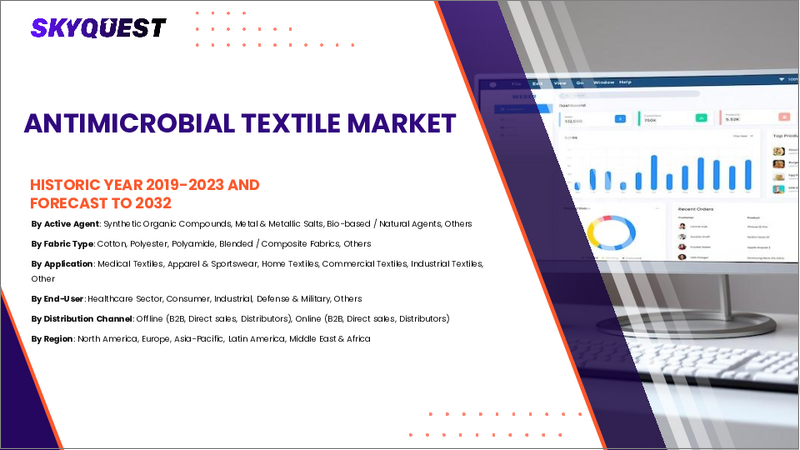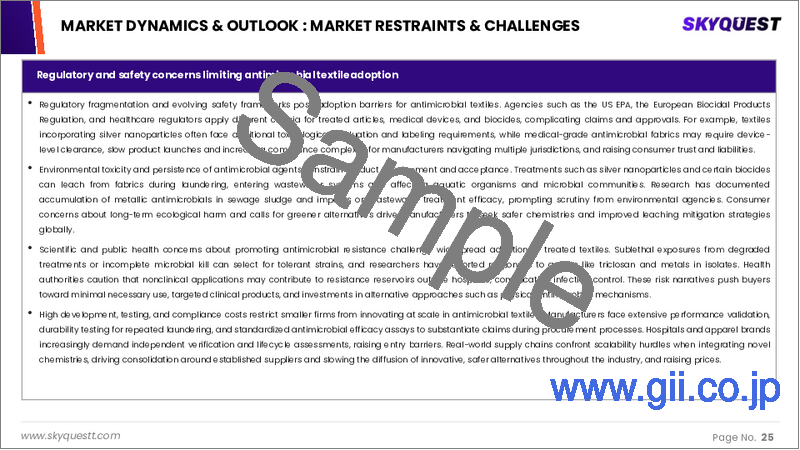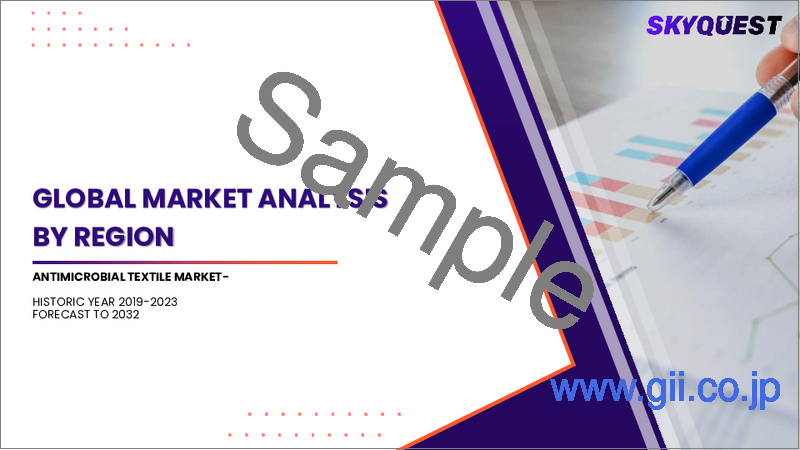|
|
市場調査レポート
商品コード
1610865
抗菌繊維市場規模、シェア、成長分析、活性剤別、生地別、用途別、地域別- 産業別予測、2024年~2031年Antimicrobial Textile Market Size, Share, Growth Analysis, By Active agents, By Fabric, By Application, By Region - Industry Forecast 2024-2031 |
||||||
|
|||||||
| 抗菌繊維市場規模、シェア、成長分析、活性剤別、生地別、用途別、地域別- 産業別予測、2024年~2031年 |
|
出版日: 2024年12月08日
発行: SkyQuest
ページ情報: 英文 238 Pages
納期: 3~5営業日
|
全表示
- 概要
- 目次
抗菌繊維の世界市場規模は2022年に117億7,000万米ドルと評価され、2023年の126億7,000万米ドルから2031年には213億米ドルに成長し、予測期間(2024年~2031年)のCAGRは7.7%で成長する見通しです。
抗菌繊維市場は、病院施設の増加や救急キットに関する政府の意識向上キャンペーンによって、特に非埋込み型製品や衛生製品などの創傷ケア分野からの需要が高まり、大きな成長が見込まれています。米国のヘルスケア産業は大幅な拡大が予測され、製品需要にプラスの影響を与えています。また、人口の高齢化、病院感染の増加、医療ツーリズムの急増なども、抗菌テキスタイルのニーズを高める要因となっています。さらに、病院関連の病気に対する意識の高まりや先進的なヘルスケア慣行、特にアジア太平洋とラテンアメリカにおける世界の生活水準と可処分所得の上昇が、市場の需要を高める可能性が高いです。
目次
イントロダクション
- 調査の目的
- 調査範囲
- 定義
調査手法
- 情報調達
- 二次データと一次データの方法
- 市場規模予測
- 市場の前提条件と制限
エグゼクティブサマリー
- 世界市場の見通し
- 供給と需要の動向分析
- セグメント別機会分析
市場力学と見通し
- 市場概要
- 市場規模
- 市場力学
- 促進要因と機会
- 抑制要因と課題
- ポーター分析と影響
- 競争企業間の敵対関係
- 代替品の脅威
- 買い手の交渉力
- 新規参入業者の脅威
- 供給企業の交渉力
主な市場の考察
- 重要成功要因
- 競合の程度
- 主な投資機会
- 市場エコシステム
- 市場の魅力指数(2023年)
- PESTEL分析
- マクロ経済指標
- バリューチェーン分析
- 価格分析
- 技術の進歩
- 規制情勢
- ケーススタディ
抗菌繊維市場規模:活性剤 & CAGR(2024年~2031年)
- 合成有機剤
- 第四級アンモニウム化合物(QAC)ポリヘキサメチレンビグアニド(PHMB)トリクロサン亜鉛ピリチオン
- 金属および金属塩
- 銀銅亜鉛など
- バイオベースの薬剤
- キトサンなど
- その他
抗菌繊維市場規模:生地別 & CAGR(2024年~2031年)
- コットン
- ポリエステル
- ポリアミド
- その他
抗菌繊維市場規模:用途別& CAGR(2024年~2031年)
- 医療用繊維
- 服装
- シーツと毛布
- 手術用品とワイプ
- その他
- 衣服
- スポーツウェア
- 下着
- アウトドアウェア
- ホームテキスタイル
- カーペット
- 寝具
- カーテンとドレープ
- その他
- 商業用繊維
- 防護服
- その他
- 産業用繊維
- HVACシステム
- フィルター
- その他
抗菌繊維市場規模:地域別& CAGR(2024年~2031年)
- 北米
- 米国
- カナダ
- 欧州
- 英国
- ドイツ
- スペイン
- フランス
- イタリア
- その他欧州
- アジア太平洋
- 中国
- インド
- 日本
- 韓国
- その他アジア太平洋
- ラテンアメリカ
- ブラジル
- その他ラテンアメリカ
- 中東・アフリカ
- GCC諸国
- 南アフリカ
- その他中東・アフリカ
競合情報
- 上位5社の比較
- 主要企業の市場ポジショニング(2023年)
- 主な市場企業が採用した戦略
- 市場の最近の動向
- 企業の市場シェア分析(2023年)
- 主要企業の企業プロファイル
- 会社概要
- 製品ポートフォリオ分析
- セグメント別シェア分析
- 収益の前年比比較(2021年~2023年)
主要企業プロファイル
- Indorama Ventures Fibers Germany
- Herculite
- UNITIKA LTD
- PurThread Technologies, Inc.
- LifeThreads
- Rajshree Fabrics.
- Baltex
- Milliken
- BioCote Ltd.
- Microban International, Ltd.
- BASF SE
- Lonza Group Ltd.
- The Dow Chemical Company
- DuPont de Nemours, Inc.
- HeiQ Materials AG
- Foss Performance Materials
- Sciessent LLC
- Sanitized AG
- PurThread Technologies, Inc.
- Sinterama S.p.A.
結論と推奨事項
Global Antimicrobial Textile Market size was valued at USD 11.77 billion in 2022 and is poised to grow from USD 12.67 billion in 2023 to USD 21.3 billion by 2031, growing at a CAGR of 7.7% in the forecast period (2024-2031).
The antimicrobial textile market is poised for significant growth due to heightened demand from the wound care sector, particularly in non-implantable and hygiene products, driven by increased hospital establishments and government awareness campaigns on first-aid kits. The U.S. healthcare industry is forecasted to experience considerable expansion, positively influencing product demand. Contributing factors also include an aging population, rising hospital infections, and a surge in medical tourism, all of which are poised to boost the need for antimicrobial textiles. Additionally, heightened awareness of hospital-related illnesses and progressive healthcare practices, along with rising living standards and disposable incomes globally, particularly in the Asia Pacific and Latin America, are likely to enhance market demand, while innovations in antimicrobial finishes will further support utilization across various sectors.
Top-down and bottom-up approaches were used to estimate and validate the size of the Global Antimicrobial Textile market and to estimate the size of various other dependent submarkets. The research methodology used to estimate the market size includes the following details: The key players in the market were identified through secondary research, and their market shares in the respective regions were determined through primary and secondary research. This entire procedure includes the study of the annual and financial reports of the top market players and extensive interviews for key insights from industry leaders such as CEOs, VPs, directors, and marketing executives. All percentage shares split, and breakdowns were determined using secondary sources and verified through Primary sources. All possible parameters that affect the markets covered in this research study have been accounted for, viewed in extensive detail, verified through primary research, and analyzed to get the final quantitative and qualitative data.
Global Antimicrobial Textile Market Segmental Analysis
Owing to limitations in the current medication therapy, treatment, and management of orthopedic, cardiovascular, ophthalmic, neurological, and a number of other chronic conditions, North America dominates the global antimicrobial fabrics market. Additionally, the antimicrobial fabrics market in the region is expected to increase due to ongoing technological advancements, which will eventually result in the production of new and improved products. Due to increased governmental involvement in improving healthcare facilities, Asia-Pacific is expected to have considerable growth in the antimicrobial textiles market. Additionally, the expanding wound care industry is predicted to increase demand for the goods, and the presence of significant yarn and fibre producers in Taiwan is predicted to further fuel the expansion of the antimicrobial textiles market in the region over the next few years.
Driver of the Global Antimicrobial Textile Market
One significant driver of the Global Antimicrobial Textile market is the rising application of antimicrobial materials in medical fabrics. These antimicrobial agents play a crucial role in eliminating or inhibiting the growth of microorganisms. Fabrics infused with these agents, either through surface treatment or incorporation within the fibers, are classified as antimicrobial textiles. The incorporation of these substances can occur during various stages, such as during the spinning or extrusion processes, or through a finishing application that includes dyes or pigments. This trend is increasingly essential for enhancing hygiene and safety in medical environments, thus boosting market growth.
Restraints in the Global Antimicrobial Textile Market
The Global Antimicrobial Textile market faces significant challenges primarily due to the ineffectiveness of active agents used in textile treatment. The efficacy of antimicrobial textiles is greatly influenced by the type of active agents and their application methods. While agents such as quaternary ammonium compounds (QAC), copper, and silver are known for their potency, they often leach out of the fabrics, diminishing their effectiveness over time. Additionally, certain substances like chitosan have limited durability, typically washing out after just a few cycles. Although ionizing metal and metallic salt treatments provide enhanced longevity, they also elevate production costs by 20-30%. These factors collectively hinder market growth.
Market Trends of the Global Antimicrobial Textile Market
The global antimicrobial textile market is witnessing robust growth, primarily driven by the rising demand for high-performance, microbe-resistant fabrics across diverse sectors such as healthcare, sportswear, and home textiles. Technological innovations in manufacturing processes enhance fabric performance and sustainability, further propelling market expansion. The influx of local enterprises fosters competitive dynamics, while heightened research and development efforts focus on developing skin-safe, effective antimicrobial agents. These advancements not only meet consumer demands for hygiene and safety but also align with evolving regulatory standards, making antimicrobial textiles a vital solution in an increasingly health-conscious market landscape.
Table of Contents
Introduction
- Objectives of the Study
- Scope of the Report
- Definitions
Research Methodology
- Information Procurement
- Secondary & Primary Data Methods
- Market Size Estimation
- Market Assumptions & Limitations
Executive Summary
- Global Market Outlook
- Supply & Demand Trend Analysis
- Segmental Opportunity Analysis
Market Dynamics & Outlook
- Market Overview
- Market Size
- Market Dynamics
- Driver & Opportunities
- Restraints & Challenges
- Porters Analysis & Impact
- Competitive rivalry
- Threat of substitute
- Bargaining power of buyers
- Threat of new entrants
- Bargaining power of suppliers
Key Market Insights
- Key Success Factors
- Degree of Competition
- Top Investment Pockets
- Market Ecosystem
- Market Attractiveness Index, 2023
- PESTEL Analysis
- Macro-Economic Indicators
- Value Chain Analysis
- Pricing Analysis
- Technological Advancement
- Regulatory Landscape
- Case Studies
Global Antimicrobial Textile Market Size by Active Agent & CAGR (2024-2031)
- Synthetic Organic Agents
- Quaternary Ammonium Compound (QAC), Polyhexamethylene Biguanides (PHMB), Triclosan, and Zinc Pyrithione)
- Metal & Metallic Salts
- Silver, Copper, Zinc, and Others)
- Bio-based Agents
- Chitosan, and Others)
- Others
Global Antimicrobial Textile Market Size by Fibers & CAGR (2024-2031)
- Cotton
- Polyester
- Polyamide
- Others
Global Antimicrobial Textile Market Size by Application & CAGR (2024-2031)
- Medical Textiles
- Attire
- Sheets & blankets
- Surgical supplies & wipes
- Others
- Apparel
- Sportswear
- Intimates
- Outdoor clothing
- Home Textiles
- Carpets
- Bedding
- Curtains & drapes
- Others
- Commercial Textiles
- Protective wear
- Others
- Industrial Textiles
- Hvac system
- Filters
- Others
Global Antimicrobial Textile Market Size by Region & CAGR (2024-2031)
- North America, (by Active Agent, by Fibers, by Application)
- US
- Canada
- Europe, (by Active Agent, by Fibers, by Application)
- UK
- Germany
- Spain
- France
- Italy
- Rest of Europe
- Asia-Pacific, (by Active Agent, by Fibers, by Application)
- China
- India
- Japan
- South Korea
- Rest of Asia Pacific
- Latin America, (by Active Agent, by Fibers, by Application)
- Brazil
- Rest of Latin America
- Middle East & Africa, (by Active Agent, by Fibers, by Application)
- GCC Countries
- South Africa
- Rest of Middle East & Africa
Competitive Intelligence
- Top 5 Player Comparison
- Market Positioning of Key Players, 2023
- Strategies Adopted by Key Market Players
- Recent Developments in the Market
- Company Market Share Analysis, 2023
- Company Profiles of All Key Players
- Company Details
- Product Portfolio Analysis
- Company's Segmental Share Analysis
- Revenue Y-O-Y Comparison (2021-2023)
Key Company Profiles
- Indorama Ventures Fibers Germany
- Company Overview
- Business Segment Overview
- Financial Updates
- Key Developments
- Herculite
- Company Overview
- Business Segment Overview
- Financial Updates
- Key Developments
- UNITIKA LTD
- Company Overview
- Business Segment Overview
- Financial Updates
- Key Developments
- PurThread Technologies, Inc.
- Company Overview
- Business Segment Overview
- Financial Updates
- Key Developments
- LifeThreads
- Company Overview
- Business Segment Overview
- Financial Updates
- Key Developments
- Rajshree Fabrics.
- Company Overview
- Business Segment Overview
- Financial Updates
- Key Developments
- Baltex
- Company Overview
- Business Segment Overview
- Financial Updates
- Key Developments
- Milliken
- Company Overview
- Business Segment Overview
- Financial Updates
- Key Developments
- BioCote Ltd.
- Company Overview
- Business Segment Overview
- Financial Updates
- Key Developments
- Microban International, Ltd.
- Company Overview
- Business Segment Overview
- Financial Updates
- Key Developments
- BASF SE
- Company Overview
- Business Segment Overview
- Financial Updates
- Key Developments
- Lonza Group Ltd.
- Company Overview
- Business Segment Overview
- Financial Updates
- Key Developments
- The Dow Chemical Company
- Company Overview
- Business Segment Overview
- Financial Updates
- Key Developments
- DuPont de Nemours, Inc.
- Company Overview
- Business Segment Overview
- Financial Updates
- Key Developments
- HeiQ Materials AG
- Company Overview
- Business Segment Overview
- Financial Updates
- Key Developments
- Foss Performance Materials
- Company Overview
- Business Segment Overview
- Financial Updates
- Key Developments
- Sciessent LLC
- Company Overview
- Business Segment Overview
- Financial Updates
- Key Developments
- Sanitized AG
- Company Overview
- Business Segment Overview
- Financial Updates
- Key Developments
- PurThread Technologies, Inc.
- Company Overview
- Business Segment Overview
- Financial Updates
- Key Developments
- Sinterama S.p.A.
- Company Overview
- Business Segment Overview
- Financial Updates
- Key Developments





